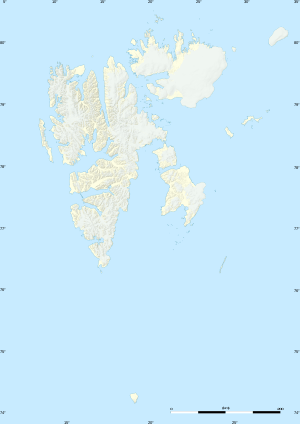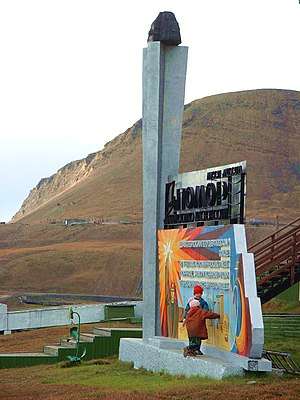Barentsburg
Barentsburg (Russian: Баренцбург) is the second-largest settlement on Svalbard, with about 470 inhabitants (2015), almost entirely made up of ethnic Russians and Ukrainians.
Barentsburg | |
|---|---|
Russian coal mining settlement | |
 The town from above | |
 Barentsburg Location in western Svalbard | |
| Coordinates: 78°04′0″N 14°13′0″E | |
| Country | Norway |
| Syssel | Svalbard |
| island | Spitsbergen |
| Population (2015) | |
| • Total | 471[1] |
| Time zone | UTC+1 (CET) |
| • Summer (DST) | UTC+2 (CEST) |
History
Rijpsburg is the name of a now abandoned Dutch settlement on Spitsbergen on Cape Boheman (Bohemanflya), at the north site of Nordfjorden in the Isfjord, roughly diagonally opposite Longyearbyen. It was built in 1920 by the Rotterdam Van der Eb and Dresselhuys Scheepvaartmaatschappij (Ship building company) with prefabricated huts for the mining of coal. Twelve Dutch staff and 52 German miners started mining coal here that year. Dutch Spitsbergen Company (NESPICO) was founded in 1920,bought a mine in Green Harbour fjord from the Russians and start coal mining from 1921 to 1926. The company renamed the settlement Barentsburg after the Dutch explorer Willem Barentsz. In 1932 the company sold the mine, including its settlement Barentsburg, to the Russian Trust Arktikugol. The population has declined over the decades; in its heyday, over 1,000 Soviet citizens inhabited Barentsburg.
2006 fire
On October 17, 2006 Norwegian inspectors detected a smoldering underground fire in Barentsburg, prompting fears that an open fire might break out,[2] which would have forced the total evacuation of Barentsburg for an indefinite period of time, and also cause environmental problems of unknown magnitude for the entire archipelago. The fire was later contained.[3] Coal mining resumed at the end of 2010.[4]
Status
Although Svalbard is under Norwegian sovereignty, the unique Svalbard Treaty of 1920 allows citizens of signatory countries equal rights to exploit natural resources. Russia, along with Norway (via the Sveagruva mine and Mine 7), maintains mining operations on Svalbard as a result. Russia maintains a consulate in Barentsburg,[5] the northernmost diplomatic mission of any kind in the world. However, Barentsburg still has a Norwegian postcode, 9178,[6] and forms part of the Norwegian telephone numbering plan.[7]
Economic basis
Barentsburg started as a Dutch mining town in the 1920s.[8] In 1932 the Dutch sold their concession to the Soviet Union.[9] Since 1932 the Russian state-owned Arktikugol Trust (Russian for "Arctic Coal") has been operating on Svalbard. The main economic activity is coal mining by the Arktikugol (Арктикуголь) company. The coal is usually exported to Northern European buyers. The town relies entirely on mainland Russia for food and coinage. There have been instances in which not enough food was sent, and aid packages were sent from Longyearbyen. Tourism is now being developed, but does not yet generate enough income to revive the town.
Transportation
The distance from Longyearbyen to Barentsburg is about 55 km but there are no roads connecting the two settlements. Most contact between the two is by boat, snowmobile, or helicopter. There is a heliport (ICAO code ENBA) with a road connection at Heerodden (78.100809°N 14.196224°E), 4 km north of Barentsburg. Tourists usually arrive via a 2-3-hour boat trip from Longyearbyen. The coal is freighted by ship. The port is located in the middle of Barentsburg.
Climate
Barentsburg features a tundra climate under the Köppen climate classification, with short, chilly “summers” and long, brutally cold winters, though winters here are noticeably warmer than winters in a number of locations with tundra climates. Due to the fact that the town is located at a latitude approaching 80 degrees, only in four months of the year have average temperatures above freezing, and in no month does the average monthly temperature exceed 10 °C (50 °F), meaning it is north of the tree line. Average low temperatures during the winter routinely drop below −15 °C (5 °F). Barentsburg averages roughly 550 millimetres (22 in) of precipitation, much of which falls as snow. In fact, the town typically experiences snowfall in every month of the year.
| Climate data for Barentsburg | |||||||||||||
|---|---|---|---|---|---|---|---|---|---|---|---|---|---|
| Month | Jan | Feb | Mar | Apr | May | Jun | Jul | Aug | Sep | Oct | Nov | Dec | Year |
| Record high °C (°F) | 6.8 (44.2) |
5.6 (42.1) |
4.1 (39.4) |
5.3 (41.5) |
9.9 (49.8) |
14.6 (58.3) |
20.3 (68.5) |
17.5 (63.5) |
12.1 (53.8) |
8.5 (47.3) |
6.8 (44.2) |
5.9 (42.6) |
20.3 (68.5) |
| Average high °C (°F) | −9.1 (15.6) |
−9.4 (15.1) |
−9.4 (15.1) |
−6.4 (20.5) |
−1.1 (30.0) |
4.0 (39.2) |
8.4 (47.1) |
7.2 (45.0) |
2.9 (37.2) |
−2.6 (27.3) |
−5.1 (22.8) |
−7.4 (18.7) |
−2.3 (27.9) |
| Daily mean °C (°F) | −12.1 (10.2) |
−12.7 (9.1) |
−12.4 (9.7) |
−9.7 (14.5) |
−3.3 (26.1) |
2.2 (36.0) |
6.0 (42.8) |
5.1 (41.2) |
1.0 (33.8) |
−4.7 (23.5) |
−7.6 (18.3) |
−10.5 (13.1) |
−4.9 (23.2) |
| Average low °C (°F) | −15.2 (4.6) |
−15.7 (3.7) |
−15.5 (4.1) |
−12.1 (10.2) |
−5.1 (22.8) |
0.8 (33.4) |
4.4 (39.9) |
3.6 (38.5) |
−0.4 (31.3) |
−6.6 (20.1) |
−10.1 (13.8) |
−12.9 (8.8) |
−7.1 (19.2) |
| Record low °C (°F) | −37.1 (−34.8) |
−39.3 (−38.7) |
−39.8 (−39.6) |
−31.3 (−24.3) |
−22.5 (−8.5) |
−9.2 (15.4) |
−0.7 (30.7) |
−3.5 (25.7) |
−12 (10) |
−27.1 (−16.8) |
−29.3 (−20.7) |
−37.3 (−35.1) |
−39.8 (−39.6) |
| Average precipitation mm (inches) | 61 (2.4) |
50 (2.0) |
56 (2.2) |
44 (1.7) |
28 (1.1) |
21 (0.8) |
25 (1.0) |
35 (1.4) |
54 (2.1) |
56 (2.2) |
59 (2.3) |
63 (2.5) |
552 (21.7) |
| Average rainy days | 2 | 1 | 2 | 1 | 3 | 10 | 17 | 16 | 12 | 4 | 3 | 2 | 73 |
| Average snowy days | 24 | 20 | 22 | 20 | 20 | 10 | 1 | 3 | 14 | 22 | 23 | 24 | 203 |
| Average relative humidity (%) | 77 | 77 | 77 | 77 | 79 | 81 | 81 | 82 | 81 | 77 | 77 | 77 | 79 |
| Source: Pogoda.ru.net[10] | |||||||||||||
Science and culture
The Barentsburg Pomor Museum presents Pomor culture, Arctic flora and fauna, and archeological objects preserved in the permafrost. It is open when the daily, summer-only boat from Longyear arrives and by special arrangement. There is an athletic complex, including a swimming pool with heated seawater.
Every summer, several dozen geophysicists, geologists, archeologists, biologists, glaciologists, geographers, etc., from Russia and elsewhere work in the scientific research centre. There is also a year-round meteorological observatory and the northernmost cosmic rays station.
Education

Barentsburg has its own school serving the Russian community; in 2014 it had three teachers, with one for most subjects, one for music, and one for the English language. By 2014 its welfare funds had declined.[11]
Gallery
.jpg) Barentsburg from the air
Barentsburg from the air Barentsburg from the seaside
Barentsburg from the seaside Barentsburg: mining and polar bears at 78° north
Barentsburg: mining and polar bears at 78° north Monument to coal
Monument to coal Russian consulate
Russian consulate- Barentsburg, as seen from the docks
 The world's second northernmost statue of Lenin (the northernmost is in Pyramiden)
The world's second northernmost statue of Lenin (the northernmost is in Pyramiden) The main street, ulitsa Ivana Starostina. The abandoned buildings on the right are being demolished as of 2013.
The main street, ulitsa Ivana Starostina. The abandoned buildings on the right are being demolished as of 2013.
| Wikimedia Commons has media related to Barentsburg. |
See also
References
- "Large population for mid-winter". ssb.no. Retrieved 21 April 2018.
- Norway Svalbard Coal Fire. International Herald Tribune. 1 November 2006.
- Barentsburg: Kullbrann kan føre til evakuering Archived June 29, 2011, at the Wayback Machine Aftenposten 1 November 2006 (in Norwegian)
- Staalesen, Atle (2010-11-08). "Russians restarted coal mining at Svalbard". Barents Observer. Retrieved 2010-01-26.
- Russian Embassy in Norway website Archived 2011-06-11 at the Wayback Machine
- 9178 BARENTSBURG SVALBARD, Posten Norge
- Consulate General in Barentsburg (Spitsbergen)
- Umbreit, Andreas (2009). Spitsbergen (4 ed.). Bradt Travel Guide. p. 35. ISBN 978-1-84162-240-8.
- Barr, Susan (2003). Norway, a consistent polar nation?: analysis of an image seen through the history of the Norwegian Polar Institute. Kolofon. p. 174. ISBN 978-82-300-0026-7.
- "Weather and Climate- The Climate of Barentsburg" (in Russian). Weather and Climate (Погода и климат). Retrieved 14 May 2015.
- Skinner, Toby (May 2014). "The Russians on Svalbard". Norwegian Air Shuttle (inflight magazine). Archived from the original on 2017-10-29.
External links

- Dream Town, Film Trailer
- Barentsburg Research Base Official site
- Barentsburg Cosmic Ray Station from the Polar Geophysical Institute
- Map and guide, with photos in English Japanese version of site
- Barentsburg photos from Galen R Frysinger site
- Many photos of Barentsburg on this flickr site
- More photos of Barentsburg from a Svalbard site
- Story on Barentsburg from the BBC, December 25, 2006